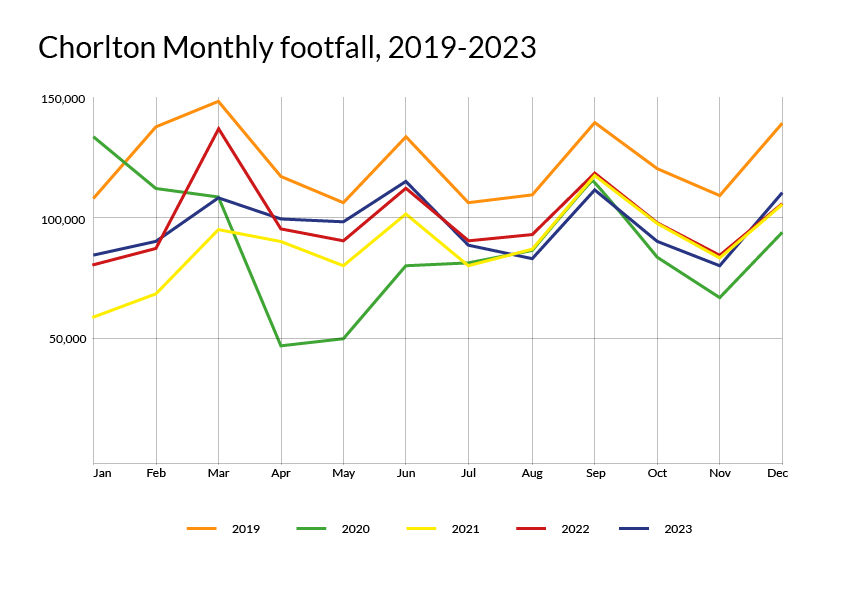Footfall Review 2023

2023 has been the year of the cycleway works. The centre of Chorlton has been subject to disruption, roadworks, closures, contraflows and traffic congestion since they began in early February 2023. The works had a significant – and highly damaging – impact on footfall, with shoppers staying away from Chorlton. This was partly due to traffic congestion and long queues, but also because pedestrian access was restricted and confusing, especially for older people and those with mobility issues. Access to individual businesses along each stretch was difficult for customers, so deliveries and passing trade were adversely affected as a result.
The raw data can be seen in the table below. We can see that footfall in Chorlton in 2023 was almost 1.5% down on 2022. While that percentage may not sound huge, it represents a drop of 17,323 people: nearly 1,500 every month. Further afield, the North and Yorkshire reported a 0.7% increase on 2022, while the UK saw an increase of 3.3% (2023 vs 2022). This shows that footfall trends in Chorlton are in direct opposition to not only the region, but also the country as a whole.
2023 was a better year for footfall than both 2020 and 2021 (though the differences should really be greater than they are), as these were pandemic years, with periods of total lockdown and Tier 3 (highest alert) status. This is why we use 2019 as the closest normal year comparison.
When comparing 2023 with 2019, the picture is stark. Chorlton’s footfall was down by 21.2% across the year. Footfall rose into six figures in only four out of twelve months in 2023, whereas in 2019, every month saw over 100,000 visitors. The 21.2% shortfall is equivalent to an astonishing 313,471 fewer people across the year – that’s more than 26,100 every month.
When we compare 2023 with 2019 regionally and nationally, we still see falls, but much smaller ones. The North and Yorkshire was down 15.8% and the UK as a whole, down 13.5%. That means Chorlton fared significantly worse than it should have done, when compared with regional and national statistics.
Trading in Chorlton has been tough in 2023. Small businesses have suffered with huge energy costs, post-Brexit restrictions, inflation and the cost-of-living crisis. And yes, there have been changes in our ‘traditional’ UK high streets, which impact on footfall, but Chorlton has performed so much worse than other places.
As we move into the second year of cycleway roadworks, we sincerely hope that things will improve. That said, with the final closure of the Precinct (February 2024) and the loss of Quality Save, AJ Adams, Boots, Frosts, Chorlton Art Market and other popular and much-loved retailers, it doesn’t look hopeful.
We know that Chorlton residents value their local high streets, but the message – now more than ever – remains the same. Please do shop local and support independent retailers and businesses as much as you can. When we have a vibrant and thriving local economy, everybody wins.
Linsey Parkinson
All figures are provided by retail analysts MRI Software (formerly Springboard). Chorlton’s figures are recorded by a footfall counter outside the Precinct on Wilbraham Road.
Chorlton's figures in detail
2023 | 2022 | 2021 | 2020 | 2019 | |
January | 83,938 | 81,582 | 58,161 | 134,158 | 107,557 |
February | 88,945 | 86,289 | 67,693 | 112,338 | 138,465 |
March | 108,982 | 136,386 | 93,888 | 108,347 | 148,565 |
April | 99,768 | 94,672 | 90,398 | 46,424 | 117,204 |
May | 98,069 | 91,139 | 80,703 | 50,603 | 106,478 |
June | 115,997 | 111,839 | 102,879 | 79,543 | 132,656 |
July | 88,979 | 90,090 | 81,723 | 81,531 | 106,370 |
August | 83,218 | 92,010 | 86,235 | 86,561 | 107,981 |
September | 112,173 | 111,701 | 116,415 | 116,368 | 140,365 |
October | 91,593 | 96,126 | 95,233 | 83,375 | 114,781 |
November | 80,333 | 83,356 | 88,715 | 66,293 | 114,768 |
December | 110,964 | 105,092 | 104,254 | 94,139 | 139,205 |
TOTALS | 1,162,959 | 1,180,282 | 1,066,297 | 1,059,682 | 1,476,430 |

